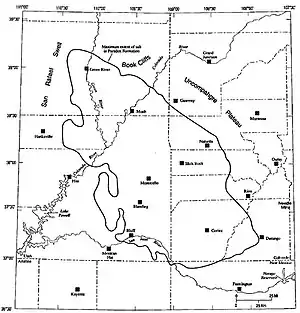
The Paradox Basin is an asymmetric foreland basin located mostly in southeast Utah and southwest Colorado, but extending into northeast Arizona and northwest New Mexico. The basin is a large elongate northwest to southeast oriented depression formed during the late Paleozoic Era. The basin is bordered on the east by the tectonically uplifted Uncompahgre Plateau, on the northwest by the San Rafael Swell and extends partway into the Monument Uplift to the west.[1]
Its area is roughly 33,000 square miles (85470 km2). The combined sedimentary strata of the Paradox Basin are more than 15,000 feet (4600 m) thick in some places.[1]
Unlike most Rocky Mountain basins, the Paradox Basin is an evaporite basin containing sediments from alternating cycles of deep marine and very shallow water. As a result of the thick salt sequences and the fact that salt is ductile at relatively low temperatures and pressures, salt tectonics play a major role in the post-Pennsylvanian structural deformation within the basin.[2][3]
History
Scientists believe the seawater at the base of Paradox Basin may have been trapped there for several hundred million years. However, in 2022 researchers attempting to date the basin unexpectedly discovered relatively "young" water as far down as three kilometers (1.9 miles). "The fresh influx would have been delivered by rainfall, snow melt or natural aquifers as recently as between 400,000 and 1.1 million years ago."[4]
Natural resources
Natural resources extracted from the basin include petroleum, uranium, copper, and potash.
Much of the petroleum production in the basin has come from porous carbonate deposits, such as algal mounds, of Pennsylvanian age. Additional reservoir types include uplifted fault blocks and discontinuous clastic beds with both stratigraphic and structural traps. The principal productive horizons in the basin include the Mississippian Leadville Limestone, the Pennsylvanian Hermosa Group (Honaker Trail, Paradox, and Pinkerton Trail formations) and the Permian age Cutler Formation.[5]
Discoveries in the Cane Creek Shale of the Paradox Formation have resulted in new oil production near Moab, Utah.[6]
See also
- Paradox Valley, which gave the basin its name
References
- 1 2 3 Nuccio, Vito F.; Condon, Steven M. (1996). "Burial and Thermal History of the Paradox Basin, Utah and Colorado, and Petroleum Potential of the Middle Pennsylvanian Paradox Formation". US Geological Survey Bulletin. 2000-O. doi:10.3133/b00O.
- ↑ "Colorado River Basin Stratigraphy". Archived from the original on 2008-05-13. Retrieved 2008-06-11.
- ↑ Davis, Jim. "Glad You Asked: Why Does A River Run Through It? – Utah Geological Survey". Archived from the original on 2019-02-09.
- ↑ Carly Cassella (22 Jul 2022). "Deep Water Under The Colorado Plateau Reveals a Hidden Surprise". ScienceAlert.
- ↑ Brown, Alan Lee (2002). Outcrop to subsurface stratigraphy of the Pennsylvanian Hermosa Group, southern Paradox Basin (dissertation). Louisiana State University. Archived (PDF) from the original on 2010-07-23. PDF file
- ↑ Jagniecki, E.A.; Gall, R.D.; Berg, M.D.V. (2019). "Geologic characterization of new Cane Creek cores from the northern part of the Paradox Basin, Utah". AAPG Rocky Mountain Section Meeting. Retrieved 8 June 2022.